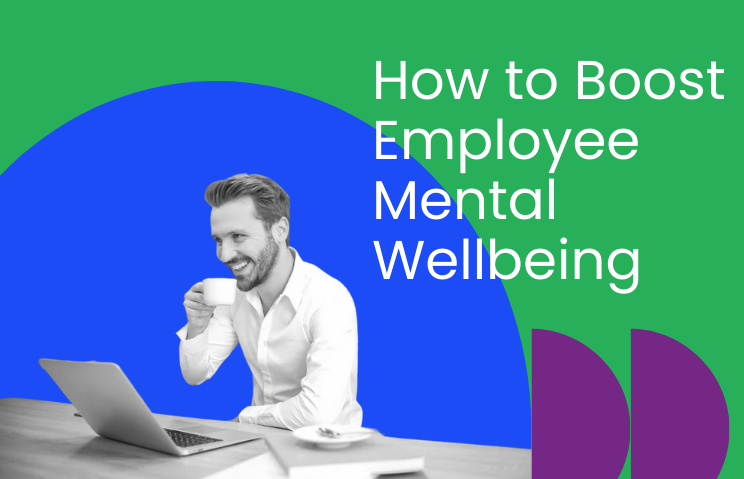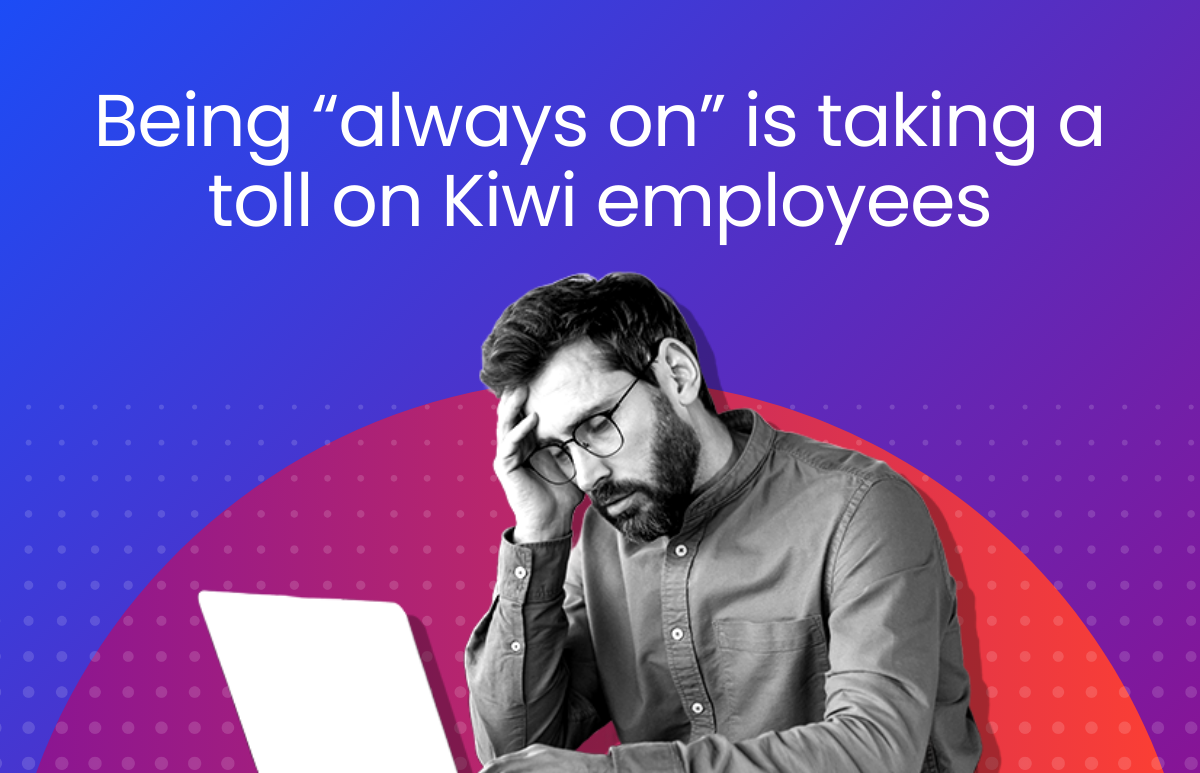How to Boost Employee Mental Wellbeing?
Imagine a workplace where employees are focused, supportive of one another, and feel a sense of purpose. This ideal work environment depends heavily on something often overlooked: employee mental wellbeing.

The consequences of ignoring mental wellbeing in the workplace are real. Stress, burnout, and low employee engagement take a toll. In fact, research by the World Health Organisation shows that depression and anxiety cost the global economy a staggering $1 trillion annually in lost productivity.
“A study by the World Health Organisation found that investing $1 in mental health treatment led to a $4 return. Improved staff wellbeing and productivity achieved this.“
WHO
Employee mental wellbeing is crucial for a successful business. It impacts factors like productivity and retention. Employers can create a supportive environment by fostering open communication and offering resources. This includes promoting work-life balance and providing wellness programs. Encouraging social connections among employees is another important step. By following these strategies, businesses can improve employee wellbeing and create a thriving workplace.
So, how can you support the mental health of your team? Let’s dive into actionable strategies.
Creating a culture of mental health support

Building a supportive workplace culture for mental health is a fundamental shift in how people think and react to mental health. It requires active change management within the business. Here are the key areas businesses should focus on to foster this change.
Open communication
Starting with the basics, encouraging open dialogue about mental health challenges is pivotal. This means creating channels where employees feel safe discussing their struggles without fear of judgement. Creating a psychologically safe atmosphere encourages employees to seek help when needed, reducing the stigma surrounding mental health support.
Encouraging open dialogue about mental health challenges is the cornerstone of a supportive workplace. When employees feel safe discussing their mental health, it encourages them to seek help when needed. Here’s how to foster open communication:
- Break the silence: Initiate conversations about mental health during team meetings or one-on-one check-ins. Share personal experiences or stories to reduce stigma.
- Training and awareness: Provide workshops or training sessions on mental health awareness. Equip employees with the knowledge to see signs of distress in themselves and their colleagues.
- Anonymous channels: Create anonymous channels (such as suggestion boxes or online platforms) where employees can share their concerns without fear of judgement.
Challenge mental health stigma
Misconceptions around mentally healthy often deter people from speaking up or seeking support. Addressing these myths through regular mental health awareness efforts and using inclusive language can help change perceptions. Educating staff on the realities of mental illness creates a more understanding and supportive workplace. Integrating mental health into health and safety training ensures everyone has a basic understanding of these important issues.
Addressing misconceptions and promoting education is essential to change stigma about mental health. Here’s how to do it effectively:
- Language matters: Use inclusive language that avoids negative stereotypes. Replace phrases like “crazy” or “unstable” with more neutral terms.
- Educate: Regularly share information about mental health through newsletters, workshops, or posters. Highlight common mental health conditions and that seeking help is a sign of strength.
- Leadership role: Leaders should actively participate in efforts to reduce mental health stigma. When executives openly discuss their mental health journeys, it sets a powerful example for the entire business.
Leadership support
Leadership plays a crucial role in shaping workplace culture. Leaders who focus on mental health, take positive actions, and discuss it openly create a better workplace. By providing necessary resources and support, leaders show that the company values its employees’ overall well-being. Data indicates that leadership support is key to implementing effective workplace mental health strategies.
Here’s how leaders can focus on mental well-being:
- Role modelling: Leaders should demonstrate healthy actions. Encourage work-life balance, take breaks, and focus on self-care.
- Resource allocation: Allocate resources for mental health initiatives. Consider employee assistance programs, counselling services, and wellness activities.
- Visibility: Leaders should visibly support mental health initiatives. Attend mental health events, share success stories, and actively engage in discussions.
Mental health and wellbeing training
Equipping managers with the skills to identify signs of distress and offer appropriate guidance is essential. Training should cover how to have supportive conversations and when to guide employees towards professional help. This makes sure managers can identify mental health problems early and know how to help in a supportive way. Research has shown that tailored training can significantly improve managers’ confidence in supporting staff experiencing mental distress .
Here’s how:
- Identifying red flags: Train managers to identify signs of stress, anxiety, or depression in team members. These may include changes in actions, decreased productivity, or withdrawal.
- Active listening: Teach active listening techniques. Managers should create a safe space for employees to express their feelings without judgement.
- Referral process: Establish a clear process for referring employees to mental health resources. Managers should know where to direct team members in need.
Adding these approaches into regular work practices places mental health at the forefront of workplace priorities. A supportive workplace can reduce absenteeism, increase productivity, and enhance employee satisfaction. companies that gives importance to mental health report higher employee engagement and lower turnover rates.
Work-life balance and flexibility

In a busy world, it’s important to balance work and life to avoid burnout and stay healthy. Flexibility in the workplace plays a crucial role in supporting employees’ mental and physical health. Here’s how to create a better work-life balance:
Flexible work arrangements
Give employees greater control over their schedules. Offer flexible hours, remote working options, or compressed workweeks whenever possible. This flexibility helps people balance work and life, reducing stress and boosting morale.
Here are some effective approaches:
- Flexible hours: Encourage employees to adjust their work hours to accommodate personal commitments. Flexibility provides people the ability to manage their duties, such as taking kids to school or attending a yoga class, in a balanced manner.
- Remote work options: Remote working has gained prominence, especially in the wake of the pandemic. Allowing employees to work from home not only enhances productivity but also manage stress in commuting.
- Compressed workweeks: Consider condensing the workweek by extending daily hours. A four-day workweek, for instance, can provide employees with an extra day to recharge.
Encourage time off
Actively promote the use of paid time off (PTO), including vacation time and designated mental health days. Remind employees that taking breaks is essential for their wellbeing and helps prevent burnout. Consider policies that prevent staff from accruing excessive unused leave.
- Paid time off (PTO): Encourage employee to take some time off to unwind and come back refreshed. Taking time away from work rejuvenates the mind and prevents burnout.
- Vacation time: Encourage employees to explore new destinations, spend quality time with loved ones, or simply unwind. A well-deserved vacation contributes to overall happiness and productivity.
- Mental health days: Acknowledge the importance of mental well-being. Mental health days allow employees to recharge, seek therapy, or engage in self-care activities.
Work-life boundaries
Support employees in setting boundaries between their work and personal lives. Advocate for disconnecting from work outside office hours and respecting limits around work-related communications.
Taking time for yourself can help you feel more positive and focused at work. Work-life balance is important to recharge and focus on your everyday life. This can help you bring a better attitude and concentration to your job.
- Disconnecting: Advocate for clear boundaries between work and personal life. Encourage employees to switch off work-related notifications during non-working hours.
- Setting limits: Remind employees that it’s acceptable to decline after-hours meetings or emails. Respect their need for downtime.
Realistic workloads and expectations
Overwork is a major drain on mental and physical resources. Ensure workloads are manageable and deadlines are achievable. Regular communication between managers and employees can prevent unreasonable expectations and help identify areas where support is needed.
- Fair workloads: Distribute tasks equitably. Overloading employees leads to stress and decreased efficiency.
- Achievable deadlines: Set realistic project timelines. Unrealistic expectations contribute to burnout.
Employee wellness programs

A comprehensive wellbeing strategy extends beyond just policies and culture. Targeted wellness programs play a vital role in directly supporting employees’ mental and physical health. Consider these options:
Employee assistance programs (EAPs)
Employee Assistance Programs provide confidential counselling and support services to employees and their families. This could cover a range of concerns including stress, anxiety, relationship difficulties, and financial worries. EAPs provide easy-to-reach mental health help, improving individual well-being and creating a stronger workforce.
Stress management programs
Stress is a major contributor to many mental and physical health problems. Offer workshops on relaxation techniques, mindfulness training, and stress reduction strategies. These programs equip employees with valuable tools to cope with workplace pressures and enhance their overall wellbeing.
Physical activity initiatives
Physical activity is a potent mood booster and stress reliever. Encourage movement through sponsored gym memberships, structured fitness classes, or even simple workplace walking challenges. Supporting physical health directly contributes to improved mental wellbeing.
Healthy eating promotions
Access to nutritious food fuels our bodies and minds, so it can pay to offer healthier snacks and catering options in the workplace. Provide education on nutrition and healthy eating habits. These healthy eating initiatives contribute to employees’ overall wellbeing and productivity.
Important Note: Wellness programs work best when they’re well-promoted, accessible, and cater to diverse employee needs.
Forbes conducted a study which found that 80% of workers prefer a job with wellness benefits. They would choose this over a job with slightly higher pay but fewer perks. Investing in holistic wellbeing sends a clear message that you value a healthy and thriving workforce.
Encouraging social connection
Positive social and emotional connections at work are essential for boosting morale, fostering employee engagement, and reducing feelings of isolation. A strong sense of community within the workplace creates a more supportive and enjoyable environment for everyone. Here’s how to cultivate these connections:
Foster a sense of community
Actively facilitate opportunities for employees to connect outside their routine tasks. Plan team-building activities that promote collaboration and healthy competition. Regular social events, whether in-person or virtual, allow colleagues to get to know each other on a more personal level. Consider creating peer support groups where employees can share experiences and offer encouragement.
Celebrate wins
Acknowledging individual and team achievements is vital for morale and a sense of shared purpose. Make a conscious effort to celebrate milestones, both big and small. Public recognition boosts spirits and reminds employees that their contributions are valued. Celebrating successes together reinforces a positive and connected workplace culture.
Mentorship programs
Pairing new employees with experienced colleagues creates a sense of belonging and support. Mentorship programs provide guidance, knowledge sharing, and opportunities for career development. Mentorship nurtures connections across the company, allowing employees at all levels to learn from each other. This shared growth leads to a stronger, more collaborative company culture.
Measuring and monitoring impact

Track the right info to see if your mental health programs are working. Here’s how to create a robust measurement strategy:
Employee surveys
Confidential surveys offer invaluable insights into employee mental health. Assess stress levels, burnout indicators, and satisfaction with current mental wellbeing support. Use validated tools like the WHO-5 Well-Being Index² for reliable data. Regular surveys help track progress over time and gauge the impact of your initiatives.
Track absenteeism and turnover
Mental health difficulties can directly impact attendance and retention. Monitor absenteeism rates for any trends that coincide with your wellbeing programs. Reduced absenteeism and improved retention may signal positive results. While not the sole indicator of mental health, these metrics provide a valuable data point in your overall insight.
Qualitative feedback
While data is important, employee experiences offer richness and context. Collect feedback or run focus groups to understand how mental health initiatives have affected employees on a personal level. These stories provide a powerful complement to quantitative data and can help shape future improvements.
Key Takeaways:
- Fostering a supportive culture is key. Encourage open communication, challenge mental health stigma, and provide leadership support.
- Promote work-life balance with flexible work arrangements, time off policies, and boundaries between work and personal life.
- Implement wellness programs like Employee Assistance Programs, stress management workshops, and social connection initiatives.
- Track the impact of your efforts through surveys, absenteeism rates, and employee feedback.
Take Action Today!
Investing in your workforce’s wellbeing has payoffs in the long term. Implementing even a few of the strategies mentioned in this article can have a significant impact on your workforce, creating a happier, healthier, and more productive work environment for everyone.
 HR Core
HR Core 









